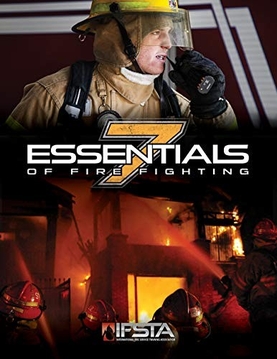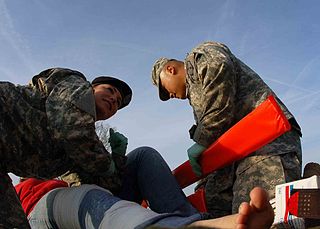Related Research Articles

Rope rescue is a subset of technical rescue that involves the use of rope, be it steel or cable rope, or more commonly used nylon, polyester, or other type of rope. Kernmantle rope as it is called, is available in various types: dynamic or static which is most commonly used in rescue and industrial rope work. Anchoring includes using specialty anchors, as well as things as simple as a length of chain, cable, rope, or webbing wrapped around a pillar, tree, boulder, or such. They provide the security and a point from which a person or subject can be belayed. Belaying is the act of protecting the climber, rescue professional, or subject in the event of a fall. Various other devices used, including friction rappel (lowering) devices, which acts as a braking device on the rope. They are used for lowering a load, a subject or oneself (rappelling). Pulleys can serve as a mechanical advantage, along with rope grabs, and other tools, to raise, or haul, a load up a vertical section, or across a gully or canyon. Pulleys systems are used in conjunction with the rope, rope grabbing devices, i.e.: Prusiks, or mechanical grabs, to capture the progress made during the lift. Since pulley systems are generally short in length, they are used in conjunction with a progress (raise) capturing technique, and a long rope; and a backup safety or belay. This specialized equipment is used to reach the subject(s) and safely recover them.
Technical rescue is the use of specialised tools and skills for rescue, including vehicle extrication, confined space rescue, rope rescue, trench rescue, structural collapse rescue, wilderness search and rescue, ice rescue, swift water rescue, underwater rescue and cave rescue. These often require specialised rescue squads as they exceed the capabilities of conventional fire departments or emergency medical services.

A certified first responder is a person who has completed a course and received certification in providing pre-hospital care for medical emergencies. Certified individuals should have received much more instruction than someone who is trained in basic first aid and cardiopulmonary resuscitation (CPR) but they are not necessarily a substitute for more advanced emergency medical care rendered by emergency medical technicians and paramedics. First responders typically provide advanced first aid level care, CPR, and automated external defibrillator (AED) usage. The term "certified first responder" is not to be confused with "first responder", which is a generic term referring to the first medically trained responder to arrive on scene and medically trained telecommunication operators who provide pre-arrival medical instructions as trained Emergency Medical Dispatchers (EMD). Many police officers and firefighters are required to receive training as certified first responders. Advanced medical care is typically provided by EMS, although some police officers and firefighters also train to become emergency medical technicians or paramedics.

The National Fire Protection Association (NFPA) is a U.S.-based international nonprofit organization devoted to eliminating death, injury, property, and economic loss due to fire, electrical, and related hazards. As of 2023, the NFPA claims to have 50,000 members and 9,000 volunteers working with the organization through its 250 technical committees.

Swift water rescue is a subset of technical rescue dealing in white water river conditions. Due to the added pressure of moving water, swift water rescue involves the use of specially trained personnel, ropes and mechanical advantage systems that are often much more robust than those used in standard rope rescue. The main goal is to use or deflect the water’s power to assist in the rescue of the endangered person(s), as in most situations there is no easy way to overcome the power of the water.
In firefighting, the policy of two-in, two-out refers to United States Occupational Safety and Health Administration (OSHA) policy 29 CFR 1910.134(g)(4)(i). The respiratory protection standard requires that workers engaged in fighting interior structural fires work in a buddy system; at least two workers must enter the building together, so that they can monitor each other's whereabouts as well as the work environment. There must also be at least two standby personnel outside the fire area prepared to rescue the inside firefighters should the need arise. One of these outside firefighters must actively monitor the status of the inside fighters but the second outside firefighter may perform a variety of other duties, such as pump operations, incident commander or outside hose line operation. There are no provisions in the standard to waive the requirements for either the "two-inside firefighters" or the "two-outside firefighters", although the circumstances under which this provision applies are more limited than generally understood.

Vehicle extrication is the process of removing a vehicle from around a person who has been involved in a motor vehicle collision, when conventional means of exit are impossible or inadvisable. A delicate approach is needed to minimize injury to the victim during the extrication. This operation is usually accomplished by using chocks and bracing for stabilization and powered rescue tools and equipment, including the Jaws of Life. Standards and regulations for organizations can be found in NFPA 1670 and for individual members in 1006.
A firefighter assist and search team (FAST), also known as a rapid intervention team/rapid intervention crew/rapid intervention group/rapid intervention dispatch (RIT/RIC/RIG/RID), is a team of two or more firefighters dedicated solely to the search and rescue of other firefighters in distress. Firefighter Assist and Search Team personnel shall have no other operational assignment during any incident. Multiple alarm fires may require multiple FAST/RIC teams.

A rescue vehicle is a specialised vehicle designed to transport and provide the equipment necessary for technical rescue. Vehicles carry an array of special equipment such as the jaws of life, wooden cribbing, generators, winches, hi-lift jacks, cranes, cutting torches, circular saws and other forms of heavy equipment unavailable on standard trucks. This capability differentiates them from traditional pumper trucks or ladder trucks designed primarily to carry firefighters and their entry gear as well as on-board water tanks, hoses and equipment for fire extinguishing and light rescue. Most rescue vehicles lack on-board water tanks and pumping gear, owing to their specialized role. A rescue vehicle is typically operated by a rescue squad, but in some areas it may be integrated with emergency medical services or fire departments.
Urban Search and Rescue Virginia Task Force 2 (VA-TF2) is one of the 28 FEMA Urban Search and Rescue Task Forces. Based in Virginia Beach, VA-TF2 is sponsored by the Virginia Beach Fire Department.
Mercia Inshore Search and Rescue (MISAR), also known as Mercia Rescue, is a water rescue team operating from the marina in Upton-upon-Severn, Worcestershire, England.

Surface water rescue is defined as the rescue of a person who is afloat on the surface of a body of water.

Essentials of Fire Fighting is a fire service training manual produced by Fire Protection Publications (FPP) and the International Fire Service Training Association (IFSTA). Fire Protection Publications is a department of Oklahoma State University College of Engineering, Architecture, and Technology (CEAT) in Stillwater, Oklahoma. This manual is used by fire service training agencies and departments around the world to train personnel to become firefighters. The Essentials of Fire Fighting is the required training manual used in countless local fire departments and state/provincial training agencies in every region of the United States and Canada. Since the release of the first edition of this manual in 1978, more than 2.5 million copies of the Essentials of Fire Fighting have been distributed to the fire service.

The Oklahoma Office of Homeland Security (OKOHS) is an agency of State of Oklahoma that is responsible for reducing the State's vulnerability to acts of terrorism and for minimizing and recovering the damage caused by terrorist attacks. OKOHS is a division of the Oklahoma Department of Public Safety.

Emergency medical responders are people who are specially trained to provide out-of-hospital care in medical emergencies. There are many different types of emergency medical responders, each with different levels of training, ranging from first aid and basic life support. Emergency medical have clinical experience or clinical skills of emergency medical services (EMS) personnel. The EMR program is not intended to replace the roles of emergency medical technicians or paramedics and their wide range of specialties. Emergency medical responders typically assist providing basic life support. "Emergency medical responder" is a broad term, used either to describe a certain EMS certification level, or generally to describe those who respond to medical emergencies. Specifically used, an Emergency Medical Responder is an EMS certification level used to describe a level of EMS provider below that of an emergency medical technician and paramedic. Broadly used, a first responder is the first medically trained personnel who comes in contact with a patient. This could be a passerby, citizen volunteer, or fire department, police, or emergency medical services personnel.

Firefighting in the United States dates back to the earliest European colonies in the Americas. Early firefighters were simply community members who would respond to neighborhood fires with buckets. The first dedicated volunteer fire brigade was established in 1736 in Philadelphia. These volunteer companies were often paid by insurance companies in return for protecting their clients.
Operations Plus WMD is a training level in dealing with hazardous materials.

Emergency Response Diving International claims to be the largest organization devoted to training emergency response divers in public safety diving (PSD). It was founded in Orlando, Florida in 2000 by Scuba Diving International in response to a high accident rate in the training of emergency response divers. The earliest lessons held by it were attended by almost 24 police officers, firefighters, and volunteers from the United States. Mitch Skaggs was one of the instructors at the founding of the organization.
NFPA 1006 is a standard published by the National Fire Protection Association which identifies the minimum job performance requirements (JPRs) for fire service and other emergency response personnel who perform technical rescue operations.
A Special operations firefighter, also known as Fire Service Special Operations, is a specialist firefighter who has been specially trained to execute tasks other than standard firefighting operations. The National Fire Protection Association's Standard for the Organization and Deployment of Fire Suppression Operations, Emergency Medical Operations, and Special Operations to the Public by Career Fire Departments defines special operations as "Those emergency incidents to which the fire department responds that require specific and advanced training and specialized tools and equipment". The NFPA 1710 further defined special operations as "Special operations include water rescue, extrication, hazardous materials, confined space entry, highangle rescue, aircraft rescue and fire fighting, and other operations requiring specialized training".
References
- ↑ "NFPA 1670" . Retrieved November 19, 2012.[ dead link ]
- ↑ "1670 Standard Development". NFPA.org. Retrieved 2023-12-11.